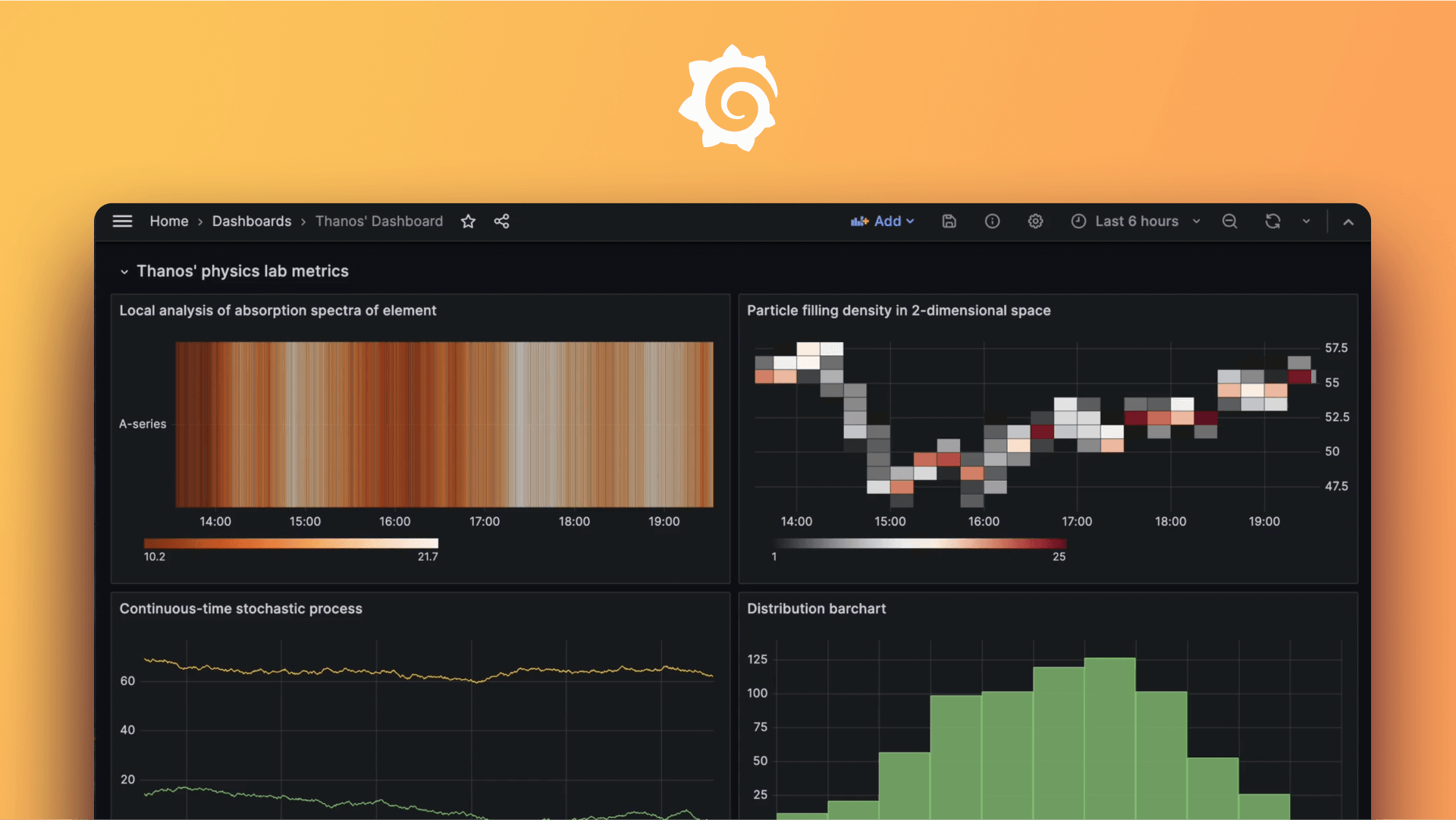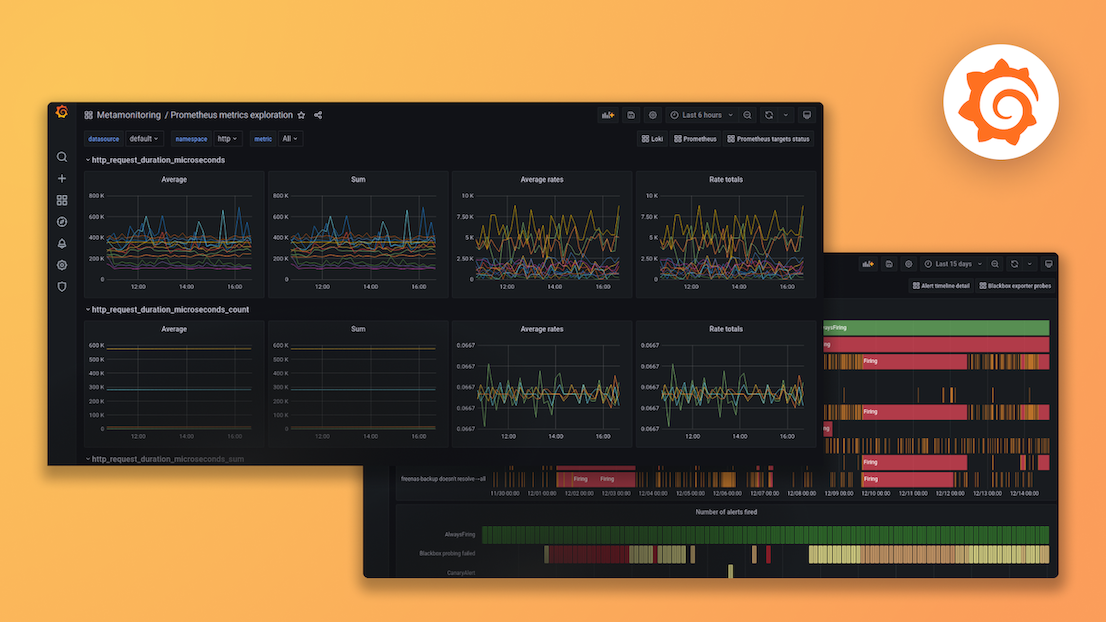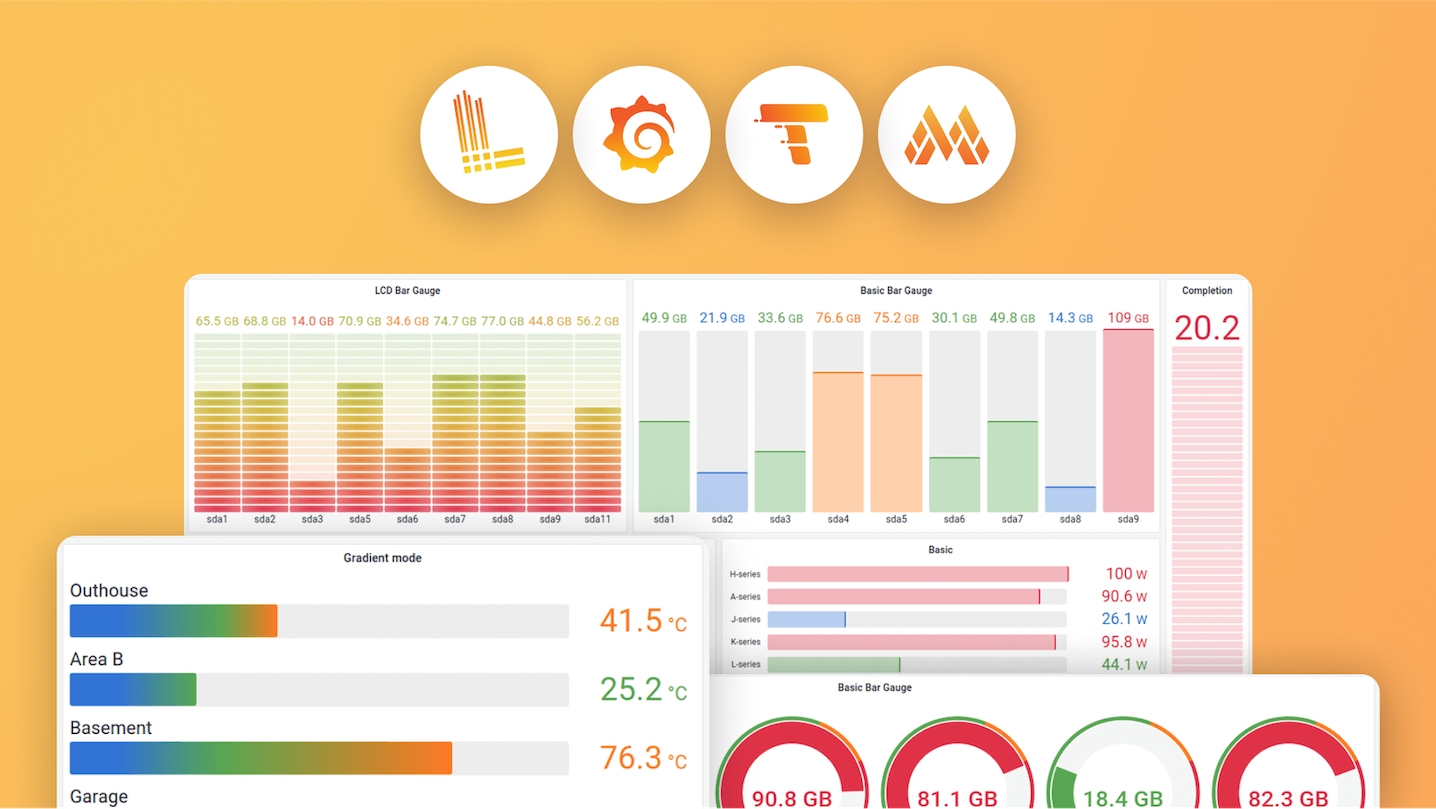Plugins 〉Warp 10
Warp 10
Grafana Warp 10™ Datasource Plugin
Install the plugin
Just clone the repository in the Grafana plugins folder
git clone git@github.com:ovh/ovh-warp10-datasource.git /var/lib/grafana/plugins/ovh-warp10-datasource
Grafana will use the dist/ folder by default
Grafana 7.0 troubleshooting
As mentioned in #71, "CORS" issues can occurs with a Warp10 datasource. To fix it:
- Or set
x_content_type_optionsto false in Grafana servers configuration settings, - Or whitelist
content-typein allow headers of Warp10 with the configuration keycors.header.
Add a new Warp 10™ Datasource
- Go to the Grafana menu (top left) > "datasources" > "add data source"
- Choose a name
- Set Warp10 as type
- Paste the Warp 10™ Platform
execendpoint URL ( do not append /api/v0/... )

Add execution variables
You can define variables at datasource level (~ organisation level) which can be available for all dashboards. you can put tokens, constants, macros, ... In case of a macro definition, the variable value must start with <%* and end with *%>. In the query you can prepend @ to the macro name to execute it.
For example, you can store a read token here:

Make a query
On a new dashboard, in a Graph visualization, click on Query icon on the left side bar, and choose Warp10 datasource.
A user friendly query editor will appear. You can use the global variable you defined previously:

It will generate WarpScript for you. The generated WarpScript is visible in your browser console:

You will see at the beginning of the query some special variables set by the plugin.
| Name | Description | Example |
|---|---|---|
| $end | Timestamp of the most recent point in the Grafana time window | 1498038153276000 |
| $endISO | end value in ISO-8601 format | '2017-06-21T09:42:33.276Z' |
| $start | Timestamp of the less recent point in the Grafana time window | 1498034553276000 |
| $startISO | start value in ISO-8601 format | '2017-06-21T08:42:33.276Z' |
| $interval | Difference between $end and $start | 3600000000 |
| $__interval | Could be used as a bucket span to display less datapoints on a graph, saving your browser RAM. See Grafana doc. | 3600000000 |
Advanced users can check the WarpScript editor and write the WarpScript they need.
To graph something on Grafana you need to return some Geo Time Series™ (GTS)
Graph example
The plugin look for GTS or GTS array in your stack, all other stack entry will be ignored. Turn on the WarpScript™ editor, and use this script:
NEWGTS
'io.warp10.grafana.test' RENAME
{ 'func' 'sinus' } RELABEL
'sinus' STORE
NEWGTS
‘io.warp10.grafana.testmetric’ RENAME
{ ‘func’ ‘cosinus’ } RELABEL
‘cosinus’ STORE
100 // Not graphable -> ignored
‘b’ // Not graphable -> ignored
$interval 20 / TOLONG ‘step’ STORE
<% $step + %> ‘stepMacro’ STORE
<% ‘index’ STORE $sinus $index NaN NaN NaN $index SIN ADDVALUE DROP %> ’execMacroSinus’ STORE
<% ‘index’ STORE $cosinus $index NaN NaN NaN $index COS ADDVALUE DROP %> ’execMacroCoinus’ STORE
$start $end $stepMacro $execMacroSinus FORSTEP
$start $end $stepMacro $execMacroCoinus FORSTEP
$sinus $cosinus

Table example
By default, the plugin build a table with the timestamp as the first column, and one column per GTS.
You can build custom tables instead of formating GTS array, if your result stack have only 1 element and this element have columns and rows property.
Then you can choose Table as Table transform in Table Options section
WarpScript™ example:
{
'columns' [
{
'text' 'columnA'
'type' 'number'
'sort' true
'desc' true
}
{
'text' 'columnB'
'type' 'number'
}
]
'rows' [
[ 10 20 ]
[ 100 200 ]
]
}

Worldmap example
You can use ovh-warp10-datasource as datasource for showing position data on grafana using grafana-worldmap-panel plugin.
In order to do it, you need to install the grafana-worldmap-panel plugin: Worldmap Panel.
When both ovh-warp10-datasource and the grafana-worldmap-panel installed, you can define a new Worldmap widget,
with a Warp 10 datasource and json result as Location Data in the Worlmap tab:


Now in your WarpScript™ you can generate data in the JSON format supported by Worldmap, for example :
'[ { "key": "amsterdam", "latitude": 52.3702, "longitude": 4.8952, "name": "Amsterdam" }, { "key": "charleroi", "latitude": 50.4108, "longitude": 4.4446, "name": "Charleroi" }, { "key": "frankfurt", "latitude": 50.110924, "longitude": 8.682127, "name": "Frankfurt" }, { "key": "london", "latitude": 51.503399, "longitude": -0.119519, "name": "London" }, { "key": "paris", "latitude": 48.864716, "longitude": 2.349014, "name": "Paris" } ]'
JSON->
And then you can see the chosen locations in the map:

You can also give a value to each location, in order to show the locations with different sizes and colors, as Worldmap allows:
'[ { "key": "amsterdam", "latitude": 52.3702, "longitude": 4.8952, "name": "Amsterdam", "value": 9 }, { "key": "charleroi", "latitude": 50.4108, "longitude": 4.4446, "name": "Charleroi", "value": 6 }, { "key": "frankfurt", "latitude": 50.110924, "longitude": 8.682127, "name": "Frankfurt", "value": 9 }, { "key": "london", "latitude": 51.503399, "longitude": -0.119519, "name": "London", "value": 12 }, { "key": "paris", "latitude": 48.864716, "longitude": 2.349014, "name": "Paris", "value": 15 } ]'
JSON->

Use Annotations
You can add Annotation on your graph: Dashboard > "Manage dashboard" > "Annotations"
Just add you WarpScript™
/!\ You must return a single GTS on TOP of your stack
Annotation example
NEWGTS
'alerts' RENAME
{ 'a' 'b' 'c' 'd' } RELABEL
$end $interval 2 / - NaN DUP DUP 'Restart WebServer' ADDVALUE
$end $interval 3 / - NaN DUP DUP 'Update v1.0.2' ADDVALUE

Define Templating variables
You can make a WarpScript query to build the choice list of your templating variables. In the dashboard settings, select Variables, and create a new one from a Query, with Warp10 as datasource. You can write any WarpScript in the Query field to build your list of choices:

- If you let several values on the stack, each value will be added to the choice list.
- Best practice: Let a list on the stack. Each value will be added to the choice list.
- Best practice: Let a map on the stack. The map keys will be added to the choice list, the map values will be available within the pannels WarpScript query. The values will be hidden from the dashboard user. This allow to hide complex values behind user friendly labels.
Here are valid queries for variable definition:

Each value is transformed into two WarpScript variables you can use in your queries:
- A string, named as you named your variable.
- A list of strings, named as you named your variable, suffixed by
_list.

- If you do not use multiple selection, variable and variable_list will contain the currently selected value
- If you use multiple selection:
- the string will contain an optimized WarpScript regular expression
- the list will contain each element selected
- If you defined a custom all value and checked "All", variable and variable_list will contain your customized value.
In the example below,
- testMap has a custom all value set to
~custom.*allvalue.* - testList has no defined custom all value.

Templating variable evaluation
To understand the variable resolution, this is how a query is built
- Inject dashboard variables ($end, $interval, etc...)
- Inject datasource execution variables (Customized by datasource)
- Inject templating variables following the configuration order (a templating variable can call the previous templating variables in its resolution)
- Inject user query (can use all previous variables)
/!\ all of the templating values are casted into strings by Grafana engine.
User friendly query builder
- <input checked="" disabled="" type="checkbox"> Basic Fetch
- <input checked="" disabled="" type="checkbox"> Bucketizer
- <input checked="" disabled="" type="checkbox"> Reducer
- <input disabled="" type="checkbox"> Renamer
- <input disabled="" type="checkbox"> Mapper
- <input disabled="" type="checkbox"> Filter
- <input disabled="" type="checkbox"> Extend limits (LIMIT, MAXOPS, MAXFETCH, ...)
- <input disabled="" type="checkbox"> Anomaly detection
Data fetching example
// you can use this public token on the https://warp.senx.io endpoint to fetch raw sensor data from a connected BeerTender.
“gCA1SVjbDkaxtmTx9ydI4TI2iGc5hFgcbCWnzMRZSt45XW8dZ53Z7VK_if28i0kXwNDLazXHgLrXUKgxLK0RbS79eJmBCpyBlIxw9US7bPfdWH4Fta51.kXN.D4Hsk5OZOwl.vLRBzMpP7F2pAMfclMXSGtCOT6F”
‘rt’ STORE
[ $rt ‘~beertender.(rawvalue|rawoffset)’ {} $end $interval ] FETCH
‘rawResult’ STORE
[ $rawResult [] ‘beertender.rawvalue’ filter.byclass ] FILTER 0 GET ‘rawvalue’ STORE
// do a linear interpolation to convert raw sensor value into percent.
// empty : 30.8e6
// full (cold): 30.52e6
30.8e6 $rawvalue - // you can substract GTS and constants
[ SWAP 0 mapper.max.x 0 0 0 ] MAP 0 GET // clamp min value to zero
2800 / //divide by 2800
[ SWAP 100 mapper.min.x 0 0 0 ] MAP 0 GET // clamp max value to 100
[ SWAP bucketizer.mean 0 1 h 0 ] BUCKETIZE // keep one point per hour, the mean of each hour.
’level in percent’ RENAME
Related links
Grafana Cloud Free
- Free tier: Limited to 3 users
- Paid plans: $55 / user / month above included usage
- Access to all Enterprise Plugins
- Fully managed service (not available to self-manage)
Self-hosted Grafana Enterprise
- Access to all Enterprise plugins
- All Grafana Enterprise features
- Self-manage on your own infrastructure
Grafana Cloud Free
- Free tier: Limited to 3 users
- Paid plans: $55 / user / month above included usage
- Access to all Enterprise Plugins
- Fully managed service (not available to self-manage)
Self-hosted Grafana Enterprise
- Access to all Enterprise plugins
- All Grafana Enterprise features
- Self-manage on your own infrastructure
Grafana Cloud Free
- Free tier: Limited to 3 users
- Paid plans: $55 / user / month above included usage
- Access to all Enterprise Plugins
- Fully managed service (not available to self-manage)
Self-hosted Grafana Enterprise
- Access to all Enterprise plugins
- All Grafana Enterprise features
- Self-manage on your own infrastructure
Grafana Cloud Free
- Free tier: Limited to 3 users
- Paid plans: $55 / user / month above included usage
- Access to all Enterprise Plugins
- Fully managed service (not available to self-manage)
Self-hosted Grafana Enterprise
- Access to all Enterprise plugins
- All Grafana Enterprise features
- Self-manage on your own infrastructure
Grafana Cloud Free
- Free tier: Limited to 3 users
- Paid plans: $55 / user / month above included usage
- Access to all Enterprise Plugins
- Fully managed service (not available to self-manage)
Self-hosted Grafana Enterprise
- Access to all Enterprise plugins
- All Grafana Enterprise features
- Self-manage on your own infrastructure
Installing Warp 10 on Grafana Cloud:
Installing plugins on a Grafana Cloud instance is a one-click install; same with updates. Cool, right?
Note that it could take up to 1 minute to see the plugin show up in your Grafana.
Installing plugins on a Grafana Cloud instance is a one-click install; same with updates. Cool, right?
Note that it could take up to 1 minute to see the plugin show up in your Grafana.
Installing plugins on a Grafana Cloud instance is a one-click install; same with updates. Cool, right?
Note that it could take up to 1 minute to see the plugin show up in your Grafana.
Installing plugins on a Grafana Cloud instance is a one-click install; same with updates. Cool, right?
Note that it could take up to 1 minute to see the plugin show up in your Grafana.
Installing plugins on a Grafana Cloud instance is a one-click install; same with updates. Cool, right?
Note that it could take up to 1 minute to see the plugin show up in your Grafana.
Installing plugins on a Grafana Cloud instance is a one-click install; same with updates. Cool, right?
Note that it could take up to 1 minute to see the plugin show up in your Grafana.
Installing plugins on a Grafana Cloud instance is a one-click install; same with updates. Cool, right?
Note that it could take up to 1 minute to see the plugin show up in your Grafana.
For more information, visit the docs on plugin installation.
Installing on a local Grafana:
For local instances, plugins are installed and updated via a simple CLI command. Plugins are not updated automatically, however you will be notified when updates are available right within your Grafana.
1. Install the Data Source
Use the grafana-cli tool to install Warp 10 from the commandline:
grafana-cli plugins install The plugin will be installed into your grafana plugins directory; the default is /var/lib/grafana/plugins. More information on the cli tool.
Alternatively, you can manually download the .zip file for your architecture below and unpack it into your grafana plugins directory.
Alternatively, you can manually download the .zip file and unpack it into your grafana plugins directory.
2. Configure the Data Source
Accessed from the Grafana main menu, newly installed data sources can be added immediately within the Data Sources section.
Next, click the Add data source button in the upper right. The data source will be available for selection in the Type select box.
To see a list of installed data sources, click the Plugins item in the main menu. Both core data sources and installed data sources will appear.



